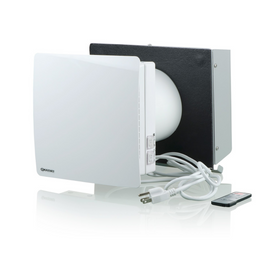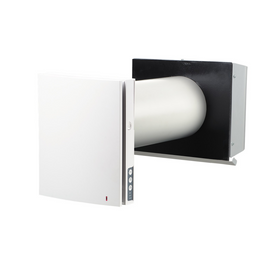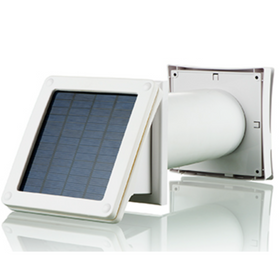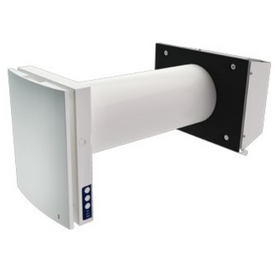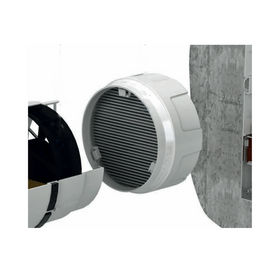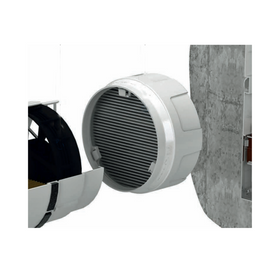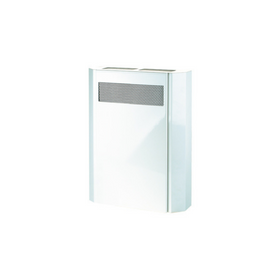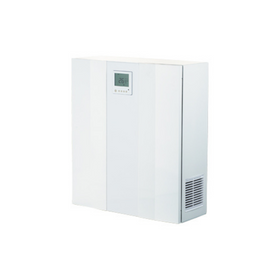
Best Ductless ERVs and HRVs for Homes in 2025
Last Updated: Jun 27, 2025Best Ductless ERVs and HRVs for Homes in 2025
Table of Contents
- Key Summary
- TL;DR
- What is a Ductless ERV/HRV and Why Does Your Home Need One?
- ERV vs. HRV: Energy Recovery Ventilator or Heat Recovery Ventilator?
- Benefits of Ductless Ventilation for Airtight Homes
- Installation and Maintenance Tips for Ductless ERVs/HRVs
- Leading Brands and Best Ductless ERV/HRV Units in 2025
- Ready to Improve Your Home’s Air? (Product Selection & Next Steps)
- Sources
Key Summary
- Ductless ERVs & HRVs Deliver Fresh Air for Airtight Homes: Modern energy-efficient homes are tightly sealed, making proper ventilation essential. Ductless Energy Recovery Ventilators (ERVs) and Heat Recovery Ventilators (HRVs) provide continuous fresh air exchange without needing extensive ductwork, maintaining healthy indoor air quality in airtight and retrofit homes.
- ERV vs. HRV – Climate and Moisture Considerations: ERVs recover both heat and moisture, ideal for humid or mixed climates (retain indoor humidity in winter, reduce incoming humidity in summer). HRVs recover heat only, best for cold, dry climates where managing moisture is less critical. Choosing ERV vs. HRV depends on your local climate and comfort needs.
- Quiet, Energy-Efficient Ventilation: Leading ductless units operate at whisper-quiet sound levels (often under 0.5 sones) and use minimal electricity. They recover 70–90% of heat from exhaust air, significantly cutting heating/cooling losses. Homeowners get fresh air without the energy penalty – a must for lowering bills and avoiding the “open window” heat loss problem.
- Top Brands – Vents US, Lunos, Cyclone: Vents US offers a broad range of ductless ventilators (from compact TwinFresh units ~30 CFM to larger Micra models up to 70 CFM) known for value, Wi-Fi options, and even solar-powered vents. Lunos (German-engineered) pioneered decentralized HRVs: pairs of sleek in-wall units with ceramic cores reaching ~90% efficiency and ultra-quiet performance. Cyclone provides affordable single-room ERVs (the SV130) with ~88% heat recovery – simple install, remote control, and solid airflow (~29 CFM) for the price.
- Health & Comfort Benefits: Ductless ERVs/HRVs continuously expel stale indoor air (removing odors, CO₂, VOCs) and bring in filtered fresh air. They help regulate humidity, reducing condensation and mold risk, and keep indoor air quality high year-round. These systems are especially beneficial after renovations or in net-zero and passive homes where natural air leakage is minimal.
- Easy Installation & Maintenance: Ductless units mount through an exterior wall with only a small vent or grille visible. Installation is often DIY-friendly (core drilling required) but professional installation is recommended for optimal performance and warranty compliance. Maintenance involves simply cleaning filters (every ~3–6 months) and occasional core cleaning – no extensive duct cleaning needed.
- Energy Savings & Year-Round Use: By recovering heat (and moisture in ERVs), these systems reduce strain on HVAC systems. Run them year-round – HRVs shine in winter by reclaiming warmth, while ERVs work in all seasons, moderating humidity in summer and keeping indoor air from becoming too dry in winter. The result is fresh air with minimal impact on your energy bills, supporting ventilation for airtight homes without sacrificing efficiency.
TL;DR
Ductless ERVs and HRVs are game-changers for home ventilation in 2025. They quietly bring fresh, oxygen-rich air into airtight homes and expel pollutants without the need for ducts. ERVs transfer heat and humidity (great for humid climates), while HRVs focus on heat recovery (best in cold, dry climates). The benefit? You get clean air and consistent indoor comfort without wasting energy. Top brands like Vents US (feature-rich TwinFresh and Micra units), Lunos (ultra-efficient pairs with ceramic cores), and Cyclone (budget-friendly single-room ERVs) offer the best ductless ERVs for homes – each known for quiet operation, easy installation, and strong performance. In short, a ductless ventilation system is an essential upgrade for anyone looking to improve indoor air quality, reduce mold and odors, and enjoy fresh air year-round in an energy-efficient home.
What is a Ductless ERV/HRV and Why Does Your Home Need One?
A ductless HRV or ERV is a compact ventilation system that provides balanced air exchange for a single room or area without requiring any central ductwork. Unlike whole-house ventilators that connect to HVAC ducts, ductless units are self-contained: you simply install them through an exterior wall. One side pulls in fresh outdoor air, while the other side exhausts stale indoor air. Inside the unit, a heat exchanger transfers warmth (and in ERVs, moisture) between the outgoing and incoming air streams. This way, even though you’re continuously ventilating, most of the heat (and in winter, humidity) stays inside your home, preserving comfort and energy.
Why are ductless systems so important now? As homes get more airtight for energy efficiency, natural drafts are eliminated – along with necessary fresh air. Tightly sealed homes can trap pollutants (like VOCs from furnishings, CO₂, cooking odors, etc.) and excess humidity. Over time, that leads to stuffy air, condensation, and even mold growth. A ductless ERV/HRV solves this by “breathing” for your home – ensuring a constant supply of fresh, filtered air and removing stale air, without major renovations. It’s a perfect solution for retrofit scenarios (say you’re upgrading an older home or finishing a basement with no existing ducts) and for spaces like bedrooms, home offices, or apartments where installing a full ducted system isn’t feasible.
How Ductless Ventilators Work: Most ductless ERVs/HRVs use a reversible fan and a ceramic or metal heat exchanger core. For example, the system might cycle in two phases: for 60–70 seconds it exhausts warm indoor air out, heating up the internal core; then it reverses flow, bringing cold outside air in over that warm core, thereby pre-warming the incoming air. This cycle repeats continuously (often two units are paired and run opposite phases to balance pressure). The result is fresh air entering at a near-room temperature, recovering typically 70–90% of the heat that would have been lost by simply opening a window. Ductless ERVs add another benefit by also transferring moisture through specialized cores, helping keep humidity levels in check.
In short, a ductless ERV/HRV gives you the best of both worlds: the health and comfort of fresh air circulation and the energy savings of heat recovery – all in a small package that installs with just a wall cut-out and standard electrical plug-in.
ERV vs. HRV: Energy Recovery Ventilator or Heat Recovery Ventilator?
You might be wondering whether you need an ERV or an HRV for your home’s ductless system. Both devices do the core job of exchanging stale indoor air with fresh outdoor air while recovering heat, but the key difference lies in humidity transfer:
- Heat Recovery Ventilators (HRVs): HRVs only exchange heat. They are designed with a heat exchanger that transfers thermal energy from one air stream to the other, but no moisture is exchanged – a physical barrier in the core separates the two air streams, so humidity stays on its original side. HRVs excel in cold, dry climates where the priority is to retain as much heat as possible during winter ventilation. By recovering heat, an HRV keeps your home warm while flushing out stale air. However, because they don’t transfer moisture, in winter an HRV will exhaust humid indoor air and bring in very dry outside air (which could further dry out your home). In dry climates or during winter, that lack of moisture transfer is usually fine or even desirable (prevents excess humidity). In humid climates, though, an HRV won’t help with high indoor moisture – you might end up with indoor air that’s too humid in summer or too dry in winter.
- Energy Recovery Ventilators (ERVs): ERVs exchange heat and humidity. They use specialized cores (often enthalpic membranes or ceramic cores) that allow water vapor to diffuse, transferring moisture between incoming and outgoing air. ERVs shine in humid or mixed climates. In winter, as you ventilate, an ERV will retain some humidity indoors (so your air doesn’t become desert-dry). In summer, an ERV will expel some of the excess humidity from incoming air (reducing the latent load on your AC). The result is a more stable indoor humidity level year-round. For example, a ductless ERV can help an air-conditioned home in a hot, humid summer by pre-drying the incoming air a bit, making the indoor climate more comfortable and lessening the chance of clamminess or mold. Keep in mind, ERVs don’t dehumidify per se, but they do even out humidity levels via transfer.
So which should you choose? Consider your climate and needs:
- If you live in a cold region (long winters) with relatively low outdoor humidity, an HRV is often the best choice for maximum heat recovery. You likely don’t want to keep indoor humidity high (to avoid condensation on super-cold days), and winters are dry anyway – an HRV will efficiently bring in fresh air and keep your heating bills down.
- If you’re in a humid or four-season climate where both hot, muggy summers and cold winters are a factor, an ERV provides a balance. It will help with humidity control in summer and prevent overly dry air in winter. This can be important for comfort (no more parched throats and static shocks in January!) and for the longevity of wood floors or furniture that prefer moderate humidity.
- Also, consider occupant needs: If maintaining a healthy humidity is crucial (say, someone has respiratory issues or you have lots of wood that can crack in dry air), lean toward an ERV. If your main goal is to tackle stale air and odors in a dry basement, an HRV could suffice.
The good news: many ductless units today blur the lines – for instance, some so-called HRVs (like the Lunos e2) actually retain a bit of moisture (about 20–30% humidity recovery) despite primarily being heat exchangers. In practice, both ERVs and HRVs will vastly improve your home’s air quality; the difference is just optimization for climate. In summary, HRV vs. ERV comes down to heat-only vs. heat+moisture recovery. Choose the one that fits your climate to get the most efficient and comfortable result.
Benefits of Ductless Ventilation for Airtight Homes
Modern homes and renovations focus on sealing up gaps and improving insulation – fantastic for efficiency, but not so great for fresh air. Let’s explore why adding a ductless ERV/HRV is one of the smartest moves for an airtight or high-performance home:
1. Continuous Fresh Air Improves Indoor Air Quality (IAQ)
Indoor air can be significantly more polluted than outdoor air if it’s not ventilated. Everyday activities (cooking, cleaning, showers) and materials (paints, furniture, carpets) release pollutants like VOCs, CO₂, particulate matter, and odors. In an airtight home, these contaminants build up, leading to stuffiness, allergies, or worse. Ductless ERVs/HRVs tackle this by constantly exchanging air. For instance, a pair of ductless units in a home might cycle air 24/7, ensuring there’s a steady supply of oxygen-rich air and exhausting pollutants outside. Homeowners often report noticeably fresher air – no more waking up to a stuffy bedroom or lingering cooking smells for days. If anyone in your household suffers from allergies or asthma, this improved IAQ can be life-changing. Plus, many ductless systems come with decent air filters (some offer up to MERV-13 filters for fine particles), so the incoming air is not only fresh but also filtered for pollen, dust, and pollution.
2. Moisture Control and Mold Prevention
Proper ventilation is a key weapon against moisture problems. Everyday living generates humidity – from showers, boiling kettles to just our breath. In a sealed home, that moisture has nowhere to go, and you may start noticing condensation on windows, or worse, hidden mold in corners and closets. Ductless ERVs help by reducing excess humidity when needed: in summer, the ERV core will transfer some of the water vapor out with the exhaust air, meaning the air entering is less humid than outside. This helps your air conditioning and prevents that sticky feeling indoors. In winter, ERVs will retain some humidity (since overly dry air can cause its own issues like cracking wood and dry sinuses), but any ventilator will also carry out overly damp air from showers and cooking. HRVs, while not actively transferring moisture, still remove humid indoor air and replace it with drier outside air in winter, which alleviates condensation. The net effect: better moisture balance. Many users find that running an HRV/ERV eliminates mild condensation issues on windows and keeps mold at bay by depriving it of stagnant, moist air. Keep in mind, if you have specific moisture-heavy areas (like a basement bathroom), you’ll still need local exhaust fans, but an HRV/ERV greatly supplements those by tackling whole-room and whole-home humidity.
3. No Ducts Needed – Perfect for Retrofits and Small Spaces
One of the strongest advantages here is right in the name ductless. If you don’t have existing HVAC ducts (common in homes with radiant heat, baseboards, or in apartments), installing a central ventilation system would normally be a major renovation. Ductless ERVs/HRVs let you add ventilation surgically – only a round hole in an exterior wall is required for each unit. This is a huge win for retrofit scenarios. For example, if you finish a previously ventless basement or attic into living space, you can put in a ductless unit rather than tearing up walls for ductwork. The units themselves are compact; some are nearly invisible on the wall except for a small vent cover. There are even models, like certain Vents US TwinFresh units, that come with slim-profile outer hoods or that can be painted to match your interior, blending in easily. And if you decide to add more ventilation later, you can do it room by room. This flexibility means even tiny homes or container homes can enjoy full HRV/ERV functionality – in fact, these systems are popular in the tiny house movement for providing fresh air without sacrificing space.
4. Quiet Operation for a Comfortable Home
You might recall old ventilation fans that roar like jet engines (bathroom fans, we’re looking at you). In contrast, today’s ductless ERVs/HRVs are engineered to be whisper-quiet. Manufacturers know these units often go in bedrooms or living rooms, so they’ve optimized motors and airflow pathways for minimal sound. Many advertise sound levels in the range of 16–30 dB at low speed – that’s about as quiet as a ticking watch or lower. In technical terms, around 0.1 to 0.5 sones is common for these products at normal settings, which is virtually imperceptible background sound. The fans use efficient DC motors and run at low RPM most of the time, keeping noise down. If you’re sensitive to noise, look for units with a “silent” or night mode. For instance, the Cyclone SV130 has sound levels around 0.2 sones on low, and Lunos e2 units are famously quiet – many homeowners say they don’t notice them running at all once installed. Bottom line: you won’t be sacrificing peace and quiet for fresh air. Unlike a central HVAC blower that can be quite audible when it kicks on, these ductless systems hum along quietly in the background, providing ventilation without bothering your sleep or conversation.
5. Energy Savings and Comfort
Ventilating without heat recovery is like throwing money out the window – literally. A ductless ERV/HRV allows you to ventilate without the energy waste. By capturing 70–90% of the heat from outgoing air, these devices greatly reduce the load on your heating system in winter and on AC in summer. Practically speaking, that means if it’s 0°C (32°F) outside and 20°C (68°F) inside, the fresh air coming in through an HRV might be, say, 16–18°C by the time it enters – your furnace only needs to nudge it a little instead of warming frigid air from scratch. Over an entire winter, this translates to real savings. The same goes for summer with an ERV: hot 30°C humid air might enter at, for example, 26°C and drier, easing the strain on your AC. Many users report that after installing these systems, they can feel the difference – the home is less drafty and temperature fluctuations are reduced, since you’re not cracking windows for air. And the electric power the units use is minimal (often on the order of 5–30 watts, similar to a small light bulb). So the cost to run an ERV/HRV is typically just a few dollars a month, easily offset by HVAC savings and the priceless benefit of healthier air. Plus, year-round use is encouraged – these are designed to run continuously. In spring and fall, you might get free cooling at night by bringing in cool air, and in winter, you recapture warmth. Net result: a comfortable, breathable home that’s also energy-efficient. You no longer have to choose between fresh air and paying a fortune in lost heat.
In summary, ductless ERVs and HRVs provide healthy air, moisture balance, quiet comfort, and energy efficiency – all packaged in a homeowner-friendly solution. They are increasingly considered an essential component of any modern high-performance home, right up there with good insulation and smart thermostats.
Installation and Maintenance Tips for Ductless ERVs/HRVs
One of the appealing aspects of ductless systems is that they’re straightforward to install compared to whole-home ventilation. However, there are still some important considerations to ensure your unit performs optimally and safely:
Placement & Number of Units: Plan where each ventilator will go. Typically, you’d install a ductless ERV/HRV high on an exterior wall in the room you want to ventilate (near the ceiling is best for circulation). Common locations are bedrooms, living rooms, and home offices – places where you spend a lot of time with doors closed. If you have a large area or an open-concept floorplan, you might need two units working in tandem for balanced airflow. Remember that some products (like Lunos e2) are sold as pairs – they work in sync, with one blowing out while the other blows in, then swapping periodically. So, you may need to budget for two units per zone for optimal performance, unless you choose a model designed as a self-contained balanced unit (like the Vents Micra or Panasonic WhisperComfort, etc., which have two internal air paths).
Wall Penetration: Installation involves drilling a core hole through your wall (usually ~6” diameter for most units). This is perhaps the trickiest part for a DIY job. You’ll need a powerful drill and a hole saw or core drill bit appropriate for your wall material. If you’re uncomfortable with this step – especially in concrete or brick walls – consider hiring a pro just for the coring portion. Many HVAC installers or even handyman services can do a wall penetration fairly quickly. Ensure the hole has a slight slope to the outside (so any condensate or rain drains outward, not into your wall).
Electrical Needs: Most ductless HRV/ERV units simply plug into a standard outlet. Check the specs: some come with a plug cord, others (typically higher-end or more permanent installations) are hard-wired. If hard-wiring is required, you’ll need an electrician to run a line or connect it to a junction box. Ensure you follow local electrical codes. The good news is power draw is low, so they rarely need a dedicated circuit. However, you might want the outlet to be switched or on a surge protector for convenience.
DIY-Friendly (But Read the Manual!): If you’re reasonably handy, installing a ductless ERV/HRV is definitely within reach. It’s often compared to installing a window air conditioner or through-wall fan, plus some wiring. The kit will include a telescoping sleeve or tube that goes through the wall, the interior and exterior grilles, and mounting hardware. Take time to seal around the exterior vent with silicone to prevent water infiltration. Level the unit correctly as per instructions. And use the provided insulation or foam seals to ensure no drafts between the unit and the wall.
Professional Installation: While DIY is possible, there are benefits to professional installation. Pros will ensure the unit is placed for optimal airflow, handle the wall cutting cleanly, and get the wiring sorted out safely. They can also sometimes calibrate the airflow (some units have adjustable settings or require pairing remotes to multiple units, etc.). Additionally, having a licensed installer might be required for the product warranty in some cases. If you’re investing in multiple units or a complex setup, professional help could save headaches.
Maintenance – Filters: Once your ductless system is up and running, maintenance is pretty simple. Filters are the main upkeep item. Most units have one or two small filters (often foam or mesh) that capture dust and pollen. You’ll want to clean or replace these on a regular schedule. Common recommendations are every 3–6 months for cleaning/replacing filters. Many homeowners align this with seasons or when they replace HVAC filters. Cleaning might be as easy as vacuuming the filter or rinsing it (if it’s washable). Some units use standard filter sizes (e.g., MERV 5 or 7) that you can buy from the manufacturer or potentially cut from bulk filter material.
Maintenance – Core Cleaning: The heat exchange core itself eventually gets a bit dusty or even moist. About once a year, plan to inspect and clean the core. For ceramic regenerative cores (like in Lunos or Cyclone), you can often carefully remove the core and either vacuum it or wash it per instructions (ceramic cores might be rinsed and fully dried). For plate heat exchangers (like in bigger units, e.g., Vents Micra), you might vacuum out the core or use compressed air. Always cut power and be gentle – the core is the heart of the system. While you have it open, wipe down the fan blades and the interior of the ducts to remove any cobwebs or debris.
What About Winter Frost? In extremely cold climates, central HRVs often have defrost mechanisms to avoid frost buildup in the core. With most ductless units, the ceramic cores inherently handle moisture by absorbing and releasing it, so many don’t require a defrost cycle (for example, the Cyclone SV130 notes that no defrost mechanism is required due to its design). However, check the manual – some units might advise switching them off or running on a certain mode if temperatures drop below a certain point (e.g., below -20°C). Typically, these systems are used successfully in cold Canadian winters, but it’s good to ensure the exterior vent hood is kept clear of snow. If you ever see frost blocking the outside grille, you might need to briefly turn off the unit to let it melt, but such cases are rare with proper installation.
Retaining Efficiency: To keep your ductless ERV/HRV running at peak efficiency, commit to those simple maintenance steps. A clogged filter or dirty core can reduce airflow and heat recovery effectiveness. Set reminders if needed. Also, avoid covering or obstructing the vents (both inside and outside). Furniture should not block the interior grille – you want the air to circulate freely in the room. Outside, keep leaves or shrubs away from the vent hood.
With installation and maintenance in hand, your ductless ventilation system should give you many years of trouble-free operation. Many brands have units running 5-10+ years with just basic care. You’ll quickly get used to the improved air quality and wonder how you lived without it!
Leading Brands and Best Ductless ERV/HRV Units in 2025
The ductless ERV/HRV market has grown in recent years as homeowners seek compact ventilation solutions. Several manufacturers stand out for their quality, performance, and innovative features. Here we highlight three leading brands – Vents US, Lunos, and Cyclone – and what makes them top choices for ductless home ventilation in 2025:
Vents US – Feature-Rich Options for Every Need
Vents US (often just called “VENTS”) offers one of the widest selections of ductless ventilators, making it easy to find a unit that fits your space and budget. They are known for combining European engineering with models tailored to North American needs. Key offerings include the TwinFresh series and Micra series:
- TwinFresh Comfo – This is a best-selling compact ERV by Vents. The TwinFresh Comfo RA1-50-2 is a through-wall unit about the size of a small round exhaust fan. It can move about 30 CFM of air, suitable for rooms up to ~500 sq. ft.. With a ceramic regenerative core, it achieves up to 88% heat recovery efficiency. The Comfo is designed to be installed in pairs (one pushes while the other pulls) for balanced ventilation, though single-unit use is possible in exhaust-only mode. What homeowners love is the simplicity – it runs quietly and even has a wireless remote. And at a price around $700 USD (as of 2025), it’s one of the most affordable ductless ERVs on the market, making it an attractive entry point for those new to ventilation.
- TwinFresh Expert (with Wi-Fi) – Vents didn’t stop at the basic model. The TwinFresh Expert variants add smart features like Wi-Fi connectivity and smartphone app control. This means you can adjust ventilation modes or link multiple units wirelessly. For example, the TwinFresh Expert RW1-50-2 Wi-Fi model can synchronize with other units in your home – when one is blowing out, another will automatically cycle to blow in, ensuring perfect balance. These models also support advanced controls like scheduling and integrating with home automation. If you’re a tech enthusiast or just want set-it-and-forget-it convenience, the Expert series is compelling (expect a bit higher price, roughly $800–$1000).
- Filters & Extras: Vents US provides optional high-grade filters (MERV-13/14) for those concerned with allergens or smoke – a nice touch for improving IAQ further. They even have a unique TwinFresh Solar wall vent option: a small fan unit powered by its own solar panel (useful for simple fresh air supply in remote areas or where running electrical wires is difficult).
- Micra 60 & 150 – Bigger Airflow Units: For larger spaces or whole apartments, Vents offers the Micra series ductless HRVs. These are bigger rectangular units that contain two fans and a counter-flow heat exchanger, allowing them to intake and exhaust simultaneously. The Micra 150, for instance, can deliver up to 71 CFM of fresh air and serve rooms ~ up to 1200 sq. ft.. Despite the higher airflow, it remains quiet (rated around 1.0–1.8 sones at different speeds, which is still very reasonable). It comes with an LCD controller and remote, giving you multiple speeds and even a timer/schedule function. Essentially, one Micra 150 in a main living area could ventilate a small entire apartment or a floor in a house. These units are more expensive (around $1,800+), but they integrate a lot of functionality in one package – including having two internal filters (supply air gets MERV-7, exhaust air has MERV-5 to protect the core). If you don’t want to manage multiple small units in different rooms, a Micra is an efficient single-unit approach.
What Makes Vents US Stand Out: Variety and value. Whether you need a tiny one-room solution or a high-capacity ventilator, they have something. They also pay attention to user experience – for example, providing remote controls, offering plug-and-play units, and having accessories for different climates (their units generally don’t need active defrost, and can handle cold weather well; the manuals specify safe operating temps, often down to -4°F/-20°C or lower). Many of their fans use EC motors (electronically commutated motors), which are very energy-efficient and long-lasting. Additionally, Vents US units are often readily available in North America (their distribution is good, and as evidenced by Rise’s own store, many models are stocked for quick shipping).
Notable Model for 2025: Vents TwinFresh Comfo RA1-50-2 – Best budget-friendly ductless ERV for small spaces (quiet, 88% efficient, <$750). Also, TwinFresh Expert Wi-Fi – Great for smart homes, allowing multi-unit coordination and app control.
Lunos – German Engineering for Whisper-Quiet Fresh Air
Lunos is a German brand that has become synonymous with ductless HRV excellence, especially in the high-performance building community (think Passive House designs). If you’re looking for a proven system that’s been used in ultra-efficient homes around the world, Lunos should be on your radar.
- Lunos e² (“e-squared”) System: The flagship of Lunos is the e² Ductless HRV. The design is elegantly simple: small plastic tubes (about 6 inches in diameter) go through your wall, with an indoor register and an outdoor hood. These units work in pairs – one blows inward while the other blows outward, then they swap direction every 50-70 seconds. Why pairs? Because by alternating, they balance the airflow and pressure in your house, and as a side benefit, one unit’s ceramic core is always charging or discharging heat to maximize recovery. The Lunos e² units are ultra-efficient: up to ~90% heat recovery efficiency, which is at the top of the class. Each pair can ventilate a living space with adjustable rates of 18, 31, or 38 m³/h (that’s roughly 11, 18, or 22 CFM per unit). While the airflow per unit is modest, in practice you’d install multiple pairs for larger homes (e.g., two pairs for a 3-bedroom house, one pair in the living area, one pair split between two bedrooms).
- Silent and Low-Energy: Lunos e² is known for its silent operation. The spec sheet shows sound pressure as low as 16.5 dB at low speed – essentially inaudible in a quiet room. Even at max, around 26 dB, it’s very quiet (for context, 30 dB is a whisper). This makes Lunos ideal for bedrooms; you can run them at night without disturbance. Energy consumption is astoundingly low: each unit uses just 1.4 to 3.3 watts depending on speed – meaning even running 4 units at high speed consumes less power than a typical LED light bulb. This efficiency is reflected in its specific power consumption of 0.09 W/m³/h, a metric that Passive House designers appreciate.
- Installation and Aesthetics: Lunos units mount flush in the wall. Inside, you see a simple circular grille (available in basic white or you can get decorative covers, even paintable ones). Outside, there’s a weather hood or flush grille. They are quite unobtrusive – many people won’t even notice them. The installation requires running wires to each unit from a controller; typically a single controller can power and manage 2-4 units. This controller lets you choose modes (e.g., balanced ventilation vs. exhaust-only vs. supply-only, as well as boost modes for higher ventilation when needed). While installation is a bit more involved (wiring the controller and potentially drilling multiple holes), the result is seamlessly integrated ventilation.
- Moisture and Comfort: Although technically the Lunos e² is an HRV (no dedicated moisture transfer membrane), the ceramic core does retain some moisture – roughly 20-30% humidity recovery. This means it does offer a mild ERV effect, helping to avoid over-drying your air in winter. Many users in mixed climates find Lunos keeps their humidity in a comfortable range. Since the units reverse direction, the ceramic acts like a sponge, absorbing moisture during one half-cycle and releasing some back during the other – clever!
- Expandable System: Lunos also makes the eGO units (a single-room ERV ideal for bathrooms or kitchens) and Next generation units with higher airflow. They even have wireless control options now. But the e² remains the most popular for most rooms. You can mix and match Lunos products – e.g., an eGO (which has two fans in one unit for continuous exhaust in a bathroom) can be installed to complement e² pairs elsewhere, all under one control system.
What Makes Lunos Stand Out: It’s the go-to choice for premium, ultra-quiet ventilation. Lunos units have been used in countless Passive House projects – a testimony to their efficiency and quality. The system’s modular nature (multiple small units instead of one centralized unit) provides redundancy and flexibility. If you only need to ventilate specific rooms (say bedrooms at night), you can do so without running a whole-house system. Also, Lunos has a long track record; spare parts like replacement fans or filters are available and the units are built to last. They don’t have fancy Wi-Fi apps (at least historically – newer controllers can interface with smart home systems though), but they are rock solid.
Consideration: Lunos is on the higher end price-wise. A Lunos e² kit (which typically includes 2 paired units and a controller) often runs around $1,500 – $2,000 depending on options (standard vs. deluxe covers, etc.). In the U.S., a pair with controller is just over $1,000 for base, but adding the fancy sound-reducing grilles or MERV-13 filters can increase cost. In Canada, due to import costs, kits are around $1,400-2,000 CAD. However, for many, the investment is worth the peace of mind and performance.
Notable Model for 2025: Lunos e² Standard Kit – two fans and a 5/UNI controller, 90% efficient HRV; the benchmark for decentralized ventilation. If noise is your top priority or you’re building a net-zero home, Lunos is hard to beat.
Cyclone – Affordable Single-Room ERVs Made in Canada
Cyclone is a Canadian manufacturer known for ventilation products (they make range hoods, bath fans, etc.), and they have ventured into the ductless ERV space with a strong offering for homeowners on a budget. The standout product from Cyclone is the SV130 Ductless ERV.
- Cyclone SV130 ERV: This unit is a through-wall ERV designed for a single room, much like the TwinFresh Comfo or Lunos e² concept. It uses a ceramic energy exchanger core and a reversible fan. The Cyclone SV130 moves about 29 CFM of air at max speed, which is sufficient for average bedrooms, living rooms, or even studio apartments (rated for rooms up to ~500 sq. ft.). It recovers up to 88% of heat from outgoing air, putting its efficiency on par with more expensive competitors. One thing to note: it comes as a single unit (you can install two for balanced flow, but they don’t communicate with each other like Lunos do – instead, you might run both on opposite cycles via timers manually). However, many people use a single SV130 in one room and find that it helps draw in fresh air while letting central HVAC handle distribution.
- User-Friendly Features: The SV130 includes a wireless remote control for switching between modes and fan speeds. This is great because you can change settings without accessing the unit on the wall (especially handy if it’s installed high up). It offers 3 fan speeds and even has a setting to temporarily boost ventilation (for instance, if a room is stuffy or after a shower). There are also 4 modes, likely including things like exchange mode (ERV mode), exhaust only, supply only, and maybe a circulation mode.
- Noise and Build: Cyclone emphasizes “Silent operation” in their specs. Indeed, the SV130 is rated around 0.2–0.5 sones on low to high, which is very quiet. This is achieved by a good quality axial DC motor and a decently insulated interior sleeve. The unit also has automatic shutters on the inside grille that close when the unit is off, preventing drafts. It includes two filters (MERV 5 equivalent) to trap dust on incoming and outgoing air. The core is treated with an antibacterial coating to prevent mold or bacterial growth inside – a nice hygiene feature.
- Installation: Installing the Cyclone SV130 is straightforward: cut a 6” hole through the wall, insert the telescopic sleeve (adjusts to wall thickness up to ~18”), and mount the interior and exterior covers. It plugs into a standard outlet. Because it’s a single-unit solution (one fan reverses direction periodically), you don’t need to install multiple or worry about wiring between units. This simplicity makes it popular for DIYers. And Cyclone, being a local brand in Canada, has customer support if needed.
- Price Point: The Cyclone SV130 tends to be priced under $1,000 (often around $800-900 USD, or roughly $1195 CAD list price as seen on Rise’s store, but actual sale prices can be lower). This makes it an attractive mid-range choice – not as cheap as a basic exhaust fan, but significantly less than some imported ERVs. It’s a good value given you get the core technology similar to pricier units.
What Makes Cyclone Stand Out: Accessibility and ease-of-use. It’s a no-fuss solution – you get almost everything in one package (even the remote). There’s no need to buy separate controllers or multiple units. This simplicity can mean lower installation cost too. Cyclone’s unit is also a great retrofit for folks who have, say, a window A/C or wall sleeve and want to replace or complement it with a ventilation unit. In terms of performance, it holds its own: 88% efficiency and 30 CFM is right in line with equivalent ductless systems. The downsides are minor: it doesn’t have smart app integration or fancy humidity sensors (it’s more manual in control). And the filter is only MERV 5 (which filters dust and pollen but not as fine as MERV 13 – though one could DIY upgrade the filter material if needed). Also, it lacks a dedicated high-grade filter add-on that some others have. But for many homeowners, those aren’t deal-breakers.
If you want to improve air quality in a particular room without overspending, the Cyclone SV130 is a solid, reliable pick. It’s especially popular in Canada (often found at home improvement stores there), but is also available in the U.S. via select distributors and online retailers.
Notable Model for 2025: Cyclone SV130 ERV – Best for budget-conscious buyers seeking an easy, one-unit solution for fresh air. Perfect for a bedroom or home office installation to quietly refresh the air and recover heat.
Beyond these three brands, it’s worth mentioning there are other players too: for instance, Panasonic has a WhisperComfort ERV (a small dual-duct ERV, though it’s more for new construction as it requires mounting between joists), Zehnder (a high-end Swiss/German company) introduced a ductless ERV called the ComfoAir 70 a few years back for super-insulated homes, and even mini-split makers like Pioneer now offer a ductless ERV unit with claimed 97% heat recovery. However, Vents, Lunos, and Cyclone remain among the most established and homeowner-friendly options in this niche as of 2025.
Ready to Improve Your Home’s Air? (Product Selection & Next Steps)
Healthy, fresh air is not a luxury – it’s something every efficient home should have. If you’ve noticed stale air, persistent odors, condensation, or you simply want the peace of mind of knowing your family is breathing clean air, it’s time to consider a ductless ERV or HRV. These systems are the quiet achievers of home comfort: set them up, maintain them occasionally, and they work in the background to keep your environment fresh and balanced.
Explore Our Curated Selections: Rise has done the homework for you in identifying the best ductless ERVs and HRVs for homes like yours. Head over to our Ductless Ventilation Products collection on the Rise online store (available in both the U.S. and Canada stores) to compare models, read reviews, and see detailed specs side by side. We feature top units including the ones discussed above – from the efficient Vents TwinFresh Comfo to the whisper-quiet Lunos e² and the budget-friendly Cyclone SV130.
Match a Solution to Your Home: Not sure which unit fits your needs? Consider using our product filters or reach out to our support for guidance. For instance:
- If you need to ventilate a bedroom quietly at night, a Lunos e² Ductless HRV system might be ideal (it’s nearly silent and very efficient).
- If you’re looking for a single unit to cover a studio or large room, check out the Vents Micra 150 HRV (higher CFM, built-in dual ducts).
- For an easy install in a condo or apartment, the Cyclone SV130 ERV is a great choice that doesn’t require linking multiple units or advanced setup.
Each product page on our site includes specifications, installation manuals, and customer reviews to help you make an informed decision. We only partner with reputable brands that meet our sustainability and performance criteria, so you can shop with confidence that any choice will elevate your home’s air quality.
Call to Action – Breathe Easier Starting Now: Don’t wait until stale air or moisture problems take a toll on your health or home. With a ductless ERV/HRV, you’ll immediately notice the difference – waking up more refreshed, concentrating better in your home office, and enjoying a odor-free, comfortable living space. Plus, you’ll be saving energy with every breath of fresh air. Click through to our collection and find the perfect ductless ERV/HRV for your home today. It’s a small upgrade for you, but a giant leap for your home’s health, comfort, and efficiency.
(After installing your new system, you might just find yourself saying, “Ah, that’s a breath of fresh air!”)
Sources
- Rise – Ductless HRV and ERVs Guide: “Ductless HRV and ERVs – Breathe New Air into Your Home.” Rise (BuildWithRise.com), Dec 2020. Comprehensive overview of how ductless ventilators work, their benefits, and brand options buildwithrise.medium.com buildwithrise.medium.com.
- Build with Rise – Cost & Climate Considerations: Details on choosing between ERV vs HRV for different climates and general cost ranges for ductless systems buildwithrise.com.
- Lunos e² Product Specifications: Lunos e² Ductless HRV System – Product Page, Lunos Canada via Rise. Technical stats on efficiency (90.6%), flow rates (18/31/38 m³/h), power usage (1.4–3.3 W), and sound levels (16.5–26 dB)shop.buildwithrise.ca lunoscanada.com.
- Cyclone SV130 Product Specifications: Cyclone SV130 Ductless ERV – Product Page, Cyclone (via Rise). Features of SV130 including 88% heat recovery, 2 reversible fan cycle, remote control, and quiet operation (0.2–0.5 sones)shop.buildwithrise.ca cyclonerangehoods.com.
- Vents TwinFresh Comfo Product Specifications: Vents TwinFresh Comfo RA1-50-2 – Product Page, Vents-US (via Rise). Highlights 30 CFM capacity, up to 88% sensible heat recovery, for rooms ~500 sq. ft., with wireless remote and Wi-Fi options on variants shop.buildwithrise.com.
- Vents Micra 150 Product Page – Vents-US Shop: Specifications for the Micra 150 ductless HRV: up to 71 CFM, two fans with counter-flow core, 85–88% efficiency, 1.0–1.8 sones, built-in MERV 5/7 filters, for spaces up to 1200 sq. ft. shop.vents-us.com.
- Green Building Advisor – Zehnder ComfoAir 70 Intro: Holladay, Martin. “Zehnder Develops a Ductless ERV.” GreenBuildingAdvisor.com, Sept 2016. Context on ductless ERVs emerging in market and comparisons of performance (Zehnder vs Panasonic vs Lunos) greenbuildingadvisor.com.
- Resicon LLC – Ductless HRV Commentary: “The Powerful Ductless Combo: Ductless Heating/Ductless HRV.” Resicon HVAC Blog, Oct 2019. Discusses real-world use of Lunos e² systems in homes without ducts, noting 90% heat recovery efficiency and need for professional installation for best results resiconllc.com.
- Pioneer ECOasis 50 ERV – Product Page: Pioneer Mini-Split. Details a newer wall-mounted ductless ERV with claimed 97% heat recovery, ~35 CFM airflow, 8W power draw, and smart controls pioneerminisplit.com.
- Build With Rise – Container Home Case Study: Groszko, Wayne. “Playful Container Cottage by the Sea goes Off-grid.” Rise, updated Feb 2025. Example of using Lunos ductless HRVs in a container home where ductwork wasn’t feasible, highlighting success in maintaining air quality in a unique project buildwithrise.medium.com buildwithrise.com.
Rise
At Rise, we strive to make sustainable home improvement easy and accessible for everyone. Whether you're building or renovating, our thoroughly vetted building products will help you reduce your carbon footprint, lower energy costs, and create a more sustainable living or working environment.

